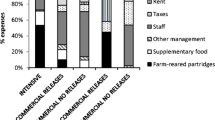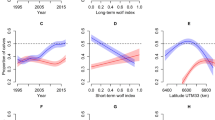Abstract
Carnivores-livestock interactions cause human-wildlife conflicts worldwide. These interactions are present under a wide range of ecological and economic circumstances. This paper studies the relationship between predation mortality and natural mortality, when food availability affects natural mortality of the livestock. Semi-domestic Saami reindeer (Rangifer t. tarandus) herding in Norway is used as a case study. When predation affects reindeer density, food competition among reindeer changes, which changes weights and natural mortality in the reindeer population. An age-structured bio-economic model is presented, where this relationship is taken into account. While predation mortality may be additional to natural mortality in absence of food limitation, it can compensate for natural mortality in situations of food scarcity. Furthermore, due to density dependency in livestock weights, predation may increase the meat value of livestock. The paper analyzes how predation affects livestock production and economic performance under an optimized management scheme. One main result is that predation shifts the optimal harvesting composition towards calf harvesting and, therefore, the optimal stock composition among the different categories of animals. This contrasts findings in the existing bioeconomic literature. Furthermore, a changing harvesting pattern towards calf harvest is an important adjustment that highly limits the negative impact on profit of predation.






Similar content being viewed by others
Notes
One management unit typically covers several reindeer owners, usually relatives of the unit manager. In western Finnmark, our case study area, there are on average 6 owners per management unit (Johannesen and Skonhoft 2011).
Exchange rate: 1 EUR = 9.25 NOK (Sept. 2016).
In reality, predation and natural mortality generally take place simultaneously. However, by sequencing the events over the annual cycle the model becomes analytically and numerically tractable. We have also studied the model when predation takes place before natural mortality. This causes a change in the distribution of losses from natural mortality to predation mortality, but has a negligible impact on the remaining results, as long as (slaughter) weights, and hence, the fertility rate and natural survival rates, depend on the autumn stock size.
Instead of using the total number of animals as density measure, we could weigh calves and adults according to, e.g., their energy intake. However, ecological studies frequently also use the total number of animals as a density measure when analyzing factors affecting animal weights (e.g., Bårdsen et al. 2010) or vegetation biomass (e.g., Kumpula et al. 2014).
Notice also that harvesting mortality has the same compensatory effect as predation mortality.
The model is solved using the Knitro solver engine (version 10.0) bundled with the Premium solver platform from Frontline systems. The stability and uniqueness of the steady states are checked by the global optimization tool Multistart. The Multistart runs the nonlinear solver a series of times, and the Multistart method`s Bayesian test determines that all locally optimal solutions are probably found. In addition, the Interval Global Solver is used to check that the baseline steady state found is a global optimum.
References
Ballard WB, Lutz D, Keegan TW, Carpenter LH, deVos JC Jr (2001) Deer-predator relationships: a review of recent North American studies with emphasis on mule and black-tailed deer. Wildl Soc Bull 29:99–115
Bårdsen BJ, Tveraa T (2012) Density-dependence vs. density-independence—linking reproductive allocation to population abundance and vegetation greenness. J Anim Ecol 81:364–376
Bårdsen BJ, Tveraa T, Fauchald P, Langeland K (2010) Observational evidence of risk-sensitive reproductive allocation in a long-lived mammal. Oecologia 162:627–639
Bårdsen BJ, Berglann H, Stien A, Tveraa T (2014) Effekten av høsting på produksjon og lønnsomhet i reindriften. NINA report 999, Tromsø
Berger KM (2006) Carnivore-livestock conflicts: effects of subsidized predator control and economic correlates in the sheep industry. Conserv Biol 20:751–761
Bertram C, Quaas MF (2017) Biodiversity and optimal multi-species ecosystem management. Environ Resour Econ 67:312–350
Boman M, Bostedt G, Persson J (2003) The bioeconomics of the spatial distribution of an endangered species. The case of the Swedish wolf population. J Bioecon 5:55–74
Borowik T, Wawrzyniak P, Jedrzejewska B (2016) Red deer (Cervus elaphus) fertility and survival of young in a low-density population subject to predation and hunting. J Mammal 97:1671–1681
Boyce MS, Sinclair ARE, White GC (1999) Seasonal compensation of predation and harvesting. Oikos 87:419–426
Caswell H (2001) Matrix population models: construction, analysis and interpretation, 2nd edn. Sinauer, Boston
Clark C (1990) Mathematical bioeconomics. Wiley, New York
Ekspertutvalget (2011) Innstilling fra ekspertutvalg vedrørende endringer i erstatningsordningen for rovviltskade på husdyr. Direktoratet for Naturforvaltning, Trondheim
Elofsson K, Mensah J, Kjellander P (2017) Optimal management of two ecologically interacting deer species—reality matters, beliefs don’t. Nat Resour Model 1:1. https://doi.org/10.1111/nrm.12137
Engel S, Pagiola S, Wunder S (2008) Designing payment for environmental services in theory and practice: an overview of the issues. Ecol Econ 85:663–674
Getz A, Haigh RG (1989) Population harvesting. Princeton University Press, Princeton
Graham K, Beckerman AP, Thirgood S (2005) Human-predator-prey conflicts: ecological correlates, prey losses and patterns of management. Biol Conserv 122:159–171
Hardin G (1968) The tragedy of the commons. Science 162:1243–1248
Hausner VH, Fauchald P, Jernsletten J-L (2012) Community-based management: under what conditions do Sámi pastoralists manage pastures sustainably? PLoS ONE 7:e51187. https://doi.org/10.1371/journal.pone.0051187
Johannesen AB, Skonhoft A (2009) Local common property exploitation with rewards. Land Econ 85:637–654
Johannesen AB, Skonhoft A (2011) Livestock as insurance and social status: evidence from reindeer herding in Norway. Environ Resour Econ 48:679–694
Johansen B, Karlsen SR (2005) Monitoring vegetation changes on Finnmarksvidda, Northern Norway, using Landsat MSS and Landsat TM/ETM + satellite images. Phytocoenologia 35:969–984
Kolowski JM, Holekamp KE (2006) Spatial, temporal, and physical characteristics of livestock depredations by large carnivores along a Kenyan reserve border. Biol Conserv 128:529–541
Kumpula J, Kurkilahti M, Helle T, Colpaert A (2014) Both reindeer management and several other land use factors explain the reduction in ground lichens (Cladonia spp.) in pastures grazed by semi-domesticated reindeer in Finland. Reg Environ Change 14:541–559
Mattisson J, Odden J, Nilsen EB, Linnell JDC, Persson J, Andrén H (2011) Factors affecting Eurasian lynx kill rates on semi-domestic reindeer in northern Scandinavia: can ecological research contribute to the development of a fair compensation system? Biol Conserv 144:3009–3017
Mattisson J, Arntsen GB, Nilsen EB, Loe LE, Linnell JDC, Odden J, Persson J, Andrén H (2014) Lynx predation on semi-domestic reindeer: do age and sex matter? J Zool 292:56–63
Mattisson J, Rauset GR, Odden J, Andrén H, Linnell JDC, Persson J (2016) Predation or Scavenging? Prey body condition influences decision-making in a facultative predator, the wolverine. Ecospehere 7(8):1–14
Mishra C (1997) Livestock depredation by large carnivores in the Indian trans-Himalaya: conflict perceptions and conservation prospects. Environ Conserv 24:338–343
Mysterud A, Yoccoz NG, Stenseth NC, Langvatn R (2001) Effects of age, sex and density on body weight of Norwegian red deer: evidence of density-dependent senescence. Proc R Soc Lond B 268:911–919
Næss MW, Bårdsen B-J (2015) Market economy vs. risk management: how do nomadic pastoralists respond to increasing meat prices? Hum Ecol 43:425–438
Naevdal E, Olaussen JO, Skonhoft A (2012) A bioeconomic model of trophy hunting. Ecol Econ 73:194–205
Nieminen M (2010) The impact of large carnivores on the mortality of semi-domesticated reindeer (Rangifer tarandus tarandus L.) calves in Kainuu, southeastern reindeer region in Finland. Rangifer 30:79–87
Nilsen E, Pettersen T, Gundersen H, Mysterud A, Milner J, Solberg E, Andreassen H, Stenseth NC (2005) Moose harvesting strategies in the presence of wolves. Spatially structured populations. J Appl Ecol 42:389–399
Norwegian Reindeer Husbandry Administration (NRHA) (2013) Totalregnskap for reindriftsnæringen, Alta
Norwegian Reindeer Husbandry Administration (NRHA) (2014) Ressursregnskap for reindriftsnæringen, Alta
Olaussen JO, Skonhoft A (2011) A cost benefit analysis of moose harvesting in Scandinavia. A stage structured modelling approach. Resour Energy Econ 33:589–611
Pekkarinen A-J, Kumpula J, Tahvonen O (2015) Reindeer management and winter pastures in the presence of supplementary feeding and government subsidies. Ecol Model 312:256–271
Pekkarinen A-J, Kumpula J, Tahvonen O (2017) Parameterization and validation of an ungulate-pasture model. Ecol Evolut 7:8282–8302
Riseth JÅ, Vatn A (2009) Modernization and pasture degradation: a comparative study of two Sami reindeer pasture regions in Norway. Land Econ 85:87–106
Sinclair ARE, Pech RP (1996) Density dependence, stochasticity, compensation and predator regulation. Oikos 75:164–173
Skonhoft A (2006) The costs and benefits of animal predation: an analysis of Scandinavian wolf re-colonization. Ecol Econ 58:830–841
Skonhoft A (2008) Sheep as capital and farmers as portfolio managers: a bioeconomic model of Scandinavian sheep farming. Agric Econ 38:193–200
Skonhoft A, Vestergaard N, Quaas M (2012) Optimal harvest in an age structured model with different fishing selectivity. Environ Resour Econ 51:525–544
Skonhoft A, Veiberg V, Gauteplasss A, Olaussen JO, Meisingset E, Mysterud A (2013) Balancing income and cost in reindeer management. J Environ Manag 115:170–188
Skonhoft A, Johannesen AB, Olaussen JO (2017) On the tragedy of the commons: when predation predation and livestock loss may improve the economic lot of herders. Ambio online March 30
St. prp. Nr. 63 (2007–2008) Om reindriftsavtalen 2008/2009 og om endringer i statsbudsjettet for 2008 m.m. Landbruks- og matdepartementet
Tahvonen O (2009) Economics of harvesting age-structured fish populations. J Environ Econ Manag 58:281–299
Tahvonen O, Quaas M, Schmidt J, Voss R (2013) Optimal harvesting of an age-structured schooling fishery. Environ Resour Econ 54:21–39
Tahvonen O, Kumpula J, Pekkarinen A-J (2014) Optimal harvesting of an age-structured, two-sex herbivore-plant system. Ecol Model 272:348–361
Tveraa, T., M. Ballesteros, B-J Bårdsen, P. Fauchald, M. Lagergren, K. Langeland, E. Pedersen, A. Stien (2012) Rovvilt og reindrift – kunnskapsstatus i Finnmark. NINA report 821, Tromsø
Tveraa T, Fauchald P, Henaug C, Yoccoz NG (2003) An examination of a compensatory relationship between food limitation and predation in semi-domestic reindeer. Popul Ecol 137:370–376
Tveraa T, Fauchald P, Yoccoz NG, Ims RA, Aanes R, Høgda KA (2007) What regulate and limit reindeer populations in Norway? Oikos 116:706–715
Tveraa T, Stien A, Bårdsen B-J, Fauchald P (2013) Population densities, vegetation green-up, and plant productivity: impact on reproductive success and juvenile body mass in reindeer. PLoS ONE 88:e56450. https://doi.org/10.1371/journal.pone.0056450
Tveraa T, Stien A, Brøseth H, Yoccoz NG (2014) The role of predation and food limitation on claims for compensation, reindeer demography and population dynamics. J Appl Ecol 51:1264–1272
Vucetich JA, Smith DW, Stahler DR (2005) Influence of harvest, climate and wolf predation on Yellowstone elk, 1961-2004. Oikos 111:259–270
Wilen JE (2000) Renewable resource economists and policy: what differences have we made? J Environ Econ Manag 39:306–327
Wilmers CC, Post E, Hastings A (2007) The anatomy of predator-prey dynamics in a changing climate. J Anim Ecol 76:1037–1044
Zabel A, Pittel K, Bostedt G, Engel S (2011) Comparing conventional and new policy approaches for carnivore conservation: theoretical results and application to tiger conservation. Environ Resour Econ 48:287–301
Zabel A, Bostedt G, Engel S (2014) Performance payments for groups: the case of carnivore conservation in northern Sweden. Environ Resour Econ 59:613–631
Author information
Authors and Affiliations
Corresponding author
Additional information
Publisher's Note
Springer Nature remains neutral with regard to jurisdictional claims in published maps and institutional affiliations.
Rights and permissions
About this article
Cite this article
Johannesen, A.B., Olaussen, J.O. & Skonhoft, A. Livestock and Carnivores: Economic and Ecological Interactions. Environ Resource Econ 74, 295–317 (2019). https://doi.org/10.1007/s10640-019-00318-x
Accepted:
Published:
Issue Date:
DOI: https://doi.org/10.1007/s10640-019-00318-x




